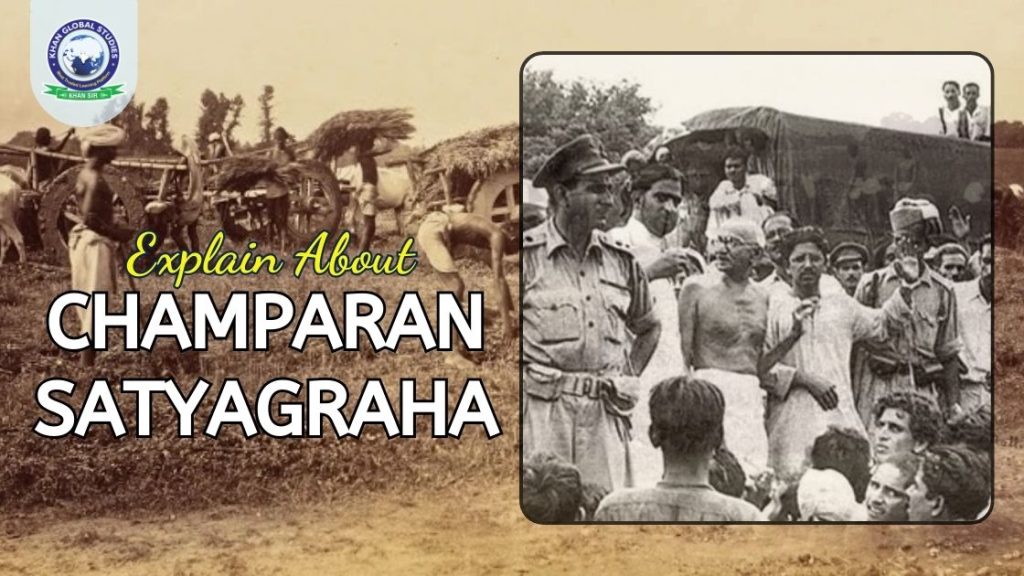Champaran District is a historical region now known as East Champaran District and West Champaran District in Bihar, India. Champaran Satyagraha, which started here in 1917, was the first Satyagraha movement under the leadership of Gandhiji and is considered a historically important rebellion in the Indian independence movement.
Champaran Satyagraha Overview
| Name of Movement | Champaran Satyagraha |
| Beginning of the Movement | 10 April 1917. (From Champaran, Bihar) |
| Originator of the Movement | Mahatma Gandhi |
| Cause of Movement | Reason for the movement against indigo cultivation and forced indigo cultivation imposed by British landlords |
| Purpose of Movement | Opposing the repressive policies of indigo cultivation, improving the economic condition of indigo farmers establishing the rights of farmers etc. |
| Method of Movement | Non-violent civil disobedience, Satyagraha. |
| Result of the Movement | Introduction of the Champaran Agricultural Act in 1918, allowing farmers to choose crops, recognition of farmers’ rights, establishment of Gandhian principles of non-violence and Satyagraha. |
| Importance of Movement | The first major non-violent protest in India was led by Gandhiji. Demonstrated the power of nonviolent resistance in achieving social and political change. |
About Champaran Satyagraha
Champaran Satyagraha of 1917 was the first Satyagraha movement in India led by Gandhiji. It was a peasant rebellion that took place in the Champaran district of Bihar, India during the British colonial period. The farmers were protesting against being paid very little for the cultivation of indigo.
When Gandhi returned to India from South Africa in 1915 and saw peasants being tortured by indigo planters in North India, he planned to use the same methods to organize a large-scale revolt by the people against injustice. He did this in South Africa.
Champaran Satyagraha was the first popular Satyagraha movement. The Champaran Satyagraha gave direction to India’s youth and freedom struggle, which was oscillating between moderates who wanted Indian participation within the British colonial system and extremists in Bengal who wanted to use violent methods to overthrow the British colonialists in India. Were. Were. wanted. Had advocated.
What is the history of Champaran Satyagraha?
History of the Champaran Satyagraha Thousands of landless slaves, indentured labourers and farmers in the Champaran district of Bihar state of India were forced to produce indigo and other cash crops instead of food crops. On 3/20 of the entire land area (called the Tinkathiya system), villagers were forced to cultivate indigo by the European colonialists.
To maximize their profits before farmers moved on to other crops when German synthetic dyes replaced indigo in the late nineteenth century, European planters demanded large rents and collected illegitimate dues from farmers, the prices at which farmers had to sell their produce were set by the Europeans. These products were purchased cheaply from farmers.
They lived in extreme poverty, were exploited by the violent forces of the landlords and received very little compensation. Although they were suffering from severe famine, the British government taxed them heavily and insisted on increasing the rates. In 1914 in Champaran (in Pipra) and in 1916 (in Turkaulia) indigo farmers rose against the government because conditions had become unbearable without food and money.
Reasons for Champaran Satyagraha
The reasons for the Champaran movement are as follows:
- Many farmers in the Champaran region of Bihar were forced to produce indigo on their properties under British administration, leaving them in great distress.
- At the time, farmers in Champaran were unable to grow the food they needed, nor were they paid enough for indigo, further adding to their misery.
- Farmers were given low wages. It was very difficult for him to survive on this meagre salary.
- Peasants were forced to give up the best part of their land to plant specific crops according to the wishes of the landlord.
- During this time, it was Raj Kumar Shukla who persuaded Mahatma Gandhi to come to Champaran, which later became the reason for Satyagraha.
Beginning of Champaran Satyagraha
Gandhiji’s role in the Champaran movement was very important. During that time, Pandit Raj Kumar Shukla, a farmer from Champaran, had persuaded Mahatma Gandhiji to visit the area because Rajkumar Shukla was unhappy with the condition of his fellow farmers. Champaran Satyagraha began as a result of Gandhiji’s visit. Gandhiji established an ashram in Champaran.
A detailed survey and study of the villages were carried out, where a group of eminent lawyers like Gandhiji’s handpicked Babu Braj Kishore Prasad, Dr Anugrah Narayan Sinha and Dr Rajendra Prasad documented the horrific incidents of degraded life, atrocities and sufferings of the Neelans. Documented, a description of the general situation revealed that under the Tinkathia system imposed by European planters, farmers had to cultivate indigo on 3/20th of their total land. By the end of the 18th century, synthetic dyes from Germany had replaced indigo and European planters were demanding heavy taxes and illegal dues from farmers.
Gandhiji’s Role in Champaran Satyagraha
Mahatma Gandhi played an important role in the Champaran Satyagraha and this can be gauged from the fact that as soon as he landed in Champaran, the British rulers started keeping an eye on Gandhiji’s activities.
It was clear that disobedience would result in Gandhiji being jailed and yet a large number of Champaran tenants demonstrated outside the jail, police stations and courts. Thus, the government, concerned about non-violent resistance, was forced to release Gandhiji.
Even after this the fighting continued and civil disobedience also continued. The Tinkathiya system or indigo cultivation was eventually abolished as a result of protests and hunger strikes. The British government forced landowners to sign an agreement that gave farmers the right to choose what to cultivate on their land, among other things.
British Reaction to Champaran Satyagraha
On 4 October 1917, the committee submitted its report to the government, making the following recommendations:
- The Tinkathiya system should be abolished.
- The ryots who had leased the factories got back one-fourth of it.
- The collection of Abwaab (illegal cess) should be stopped.
- If someone agrees to grow indigo it should be voluntary; The tenure should not exceed three years, and the decision to select the area where indigo will be grown should be made by the ryots.
- The government accepted the recommendations of the inquiry committee and later the Champaran Agricultural Act was passed in 1918.
- Thus the Tinkathiya system (which had been in place for almost a century) was abolished.
What is the importance of Champaran Satyagraha?
The Champaran Satyagraha was a revelation in the history of Indian independence. This gave rise to a hitherto unheard-of method of countering royal oppression with a force more powerful than all physical forces. Gandhiji called it Satyagraha. The first Civil Disobedience Movement was the first peasant movement to gain nationwide attention and in many ways, it inspired the people of India to join the liberation struggle against the British colonialists.
The Champaran Satyagraha was the movement that was responsible for placing Gandhiji at the front seat of the Indian nationalist movement and making Satyagraha a powerful tool of civil resistance. This is considered to be the first important step towards the birth of Mahatma Gandhi’s political experiment of non-violent resistance. There have been farmer movements before and after the Champaran Movement of 1917, but what makes the Champaran Satyagraha important is that it was the first time that bridges were built between the farmers and other sections in particular.
Furthermore, while the farmers’ grievances were only partially addressed in the final resolution, the idea that the powerful British could be forced to surrender captured the imagination of thousands of Indians fighting for independence.
What was the result of Champaran Satyagraha?
If we look at the outcome of the Champaran Satyagraha, the Champaran Agricultural Act 1918, signed by the Governor General of India on 1 May of the same year, was an important outcome of the movement protecting the interests of the farmers.
Due to the Champaran Satyagraha, Mahatma Gandhi emerged as one of the most acceptable personalities in the Indian freedom struggle at the national level. This ultimately gave rise to various freedom struggle movements led by Gandhiji, resulting in India’s independence in 1947.
Must Watch:
FAQs
Question: Who started Champaran Satyagraha?
Answer: Mahatma Gandhi started the Champaran Satyagraha against the Tinkathiya system in 1917.
Question: What was the result of Champaran Satyagraha?
Answer: The Champaran movement resulted in the abolition of the Tinkathiya system and the ryots who paid taxes to the factories got back one-fourth of the same.
Question: Who inspired Mahatma Gandhi to come to Champaran?
Answer: Hostility towards indigo cultivation forced Raj Kumar Shukla, a prosperous farmer, to persuade Mahatma Gandhi to come to Champaran and work for the suffering farmers.




